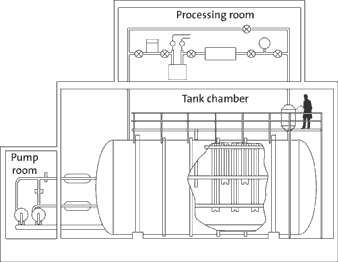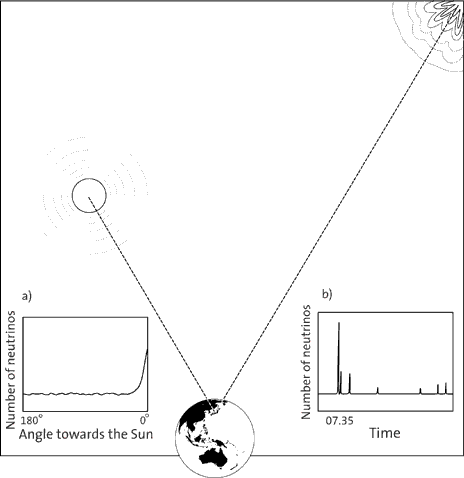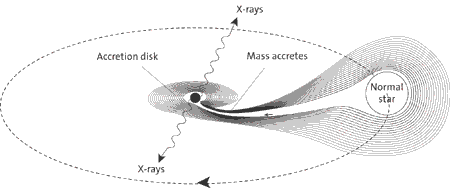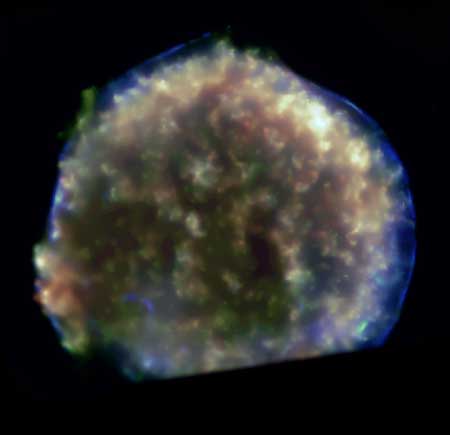Popular information
English
Swedish

The Nobel Prize in Physics 2002
This year’s Nobel Prize in Physics is concerned with the discoveries and detection of cosmic particles and radiation, from which two new fields of research have emerged, neutrino astronomy and X-ray astronomy. The Prize is awarded with one half jointly to: Raymond Davis Jr, Department of Physics and Astronomy, University of Pennsylvania, Philadelphia, USA, and Masatoshi Koshiba, International Center for Elementary Particle Physics, University of Tokyo, Japan, “for pioneering contributions to astrophysics, in particular for the detection of cosmic neutrinos”, and the second half to Riccardo Giacconi, Associated Universities, Inc., Washington, DC, USA, “for pioneering contributions to astrophysics, which have led to the discovery of cosmic X-ray sources”. Here is a description of the scientists’ award-winning achievements.
Two New Windows on the Universe
Why does the Sun shine?
In the 19th century there were lively discussions about the source of the Sun’s energy. One theory was that this solar reaction was due to the release of gravitational energy when the Sun’s material contracted. However, in this case, the calculated life expectancy of the Sun was, in our eyes, short. It was approximately 20 million years, compared with the age of the Earth, which we know today is approximately 5 billion years.
In 1920, an experiment showed that a helium atom has less mass than four hydrogen atoms. The British astrophysicist Sir Arthur Eddington realised that nuclear reactions in which hydrogen was transformed into helium might be the basis of the Sun’s energy supply, using Albert Einstein’s formula E=m·c2. The transformation of hydrogen into helium in the Sun gives rise to two neutrinos for each helium nucleus that is formed by a series of reactions (explained by, among others, the Nobel Prize Laureate Hans Bethe). The dream of verifying this theory by detecting neutrinos was considered a practical impossibility by most scientists. However, in the 1950s the Nobel Prize Laureate Frederick Reines and his colleagues succeeded in showing that it was possible to prove the existence of neutrinos. In their experiment they used the reactions in a nuclear reactor, which generates a large flux of neutrinos.

High resolution image (jpeg 236kb)
Fig. 1 Davis’s detector, which for the first time in history proved the existence of solar neutrinos. The tank, which was placed in a gold mine, contained more than 600 tonnes of tetrachloroethylene and was 14.6 metres long, with a diameter of 6.1 metres.
The flux of neutrinos from the Sun was estimated to be very large: thousands of billions of solar neutrinos were reckoned to pass through our bodies every second without our noticing them. The reason is that these neutrinos react very weakly with matter, and only one of 1,000 billion solar neutrinos would be stopped on its way through the Earth.
In the late 1950s Raymond Davis Jr was the only scientist who dared to try to prove the existence of solar neutrinos, despite these poor odds. While most reactions in the Sun create neutrinos with energies so low that they are very difficult to detect, one rare reaction creates a high-energy neutrino. The Italian physicist Bruno Pontecorvo proposed that it ought to be possible to detect this neutrino after it had reacted with a nucleus of chlorine, forming a nucleus of argon and an electron. This argon nucleus is radioactive and has a life of about 50 days.
Particles captured in mines
In the 1960s Davis placed a tank filled with 615 tonnes of the common cleaning fluid tetrachloroethylene (Fig. 1) in a gold mine in South Dakota, USA. Altogether there were some 2·1030 chlorine atoms in the tank. He calculated that every month approximately 20 neutrinos ought to react with the chlorine, or in other words that 20 argon atoms ought to be created. Davis’s pioneering approach was the development of a method for extracting these argon atoms and measuring their number. He released helium gas through the chlorine fluid and the argon atoms attached themselves to it – an achievement considerably more difficult than finding a particular grain of sand in the whole of the Sahara desert!
This experiment gathered data until 1994 and all in all approximately 2,000 argon atoms were extracted. However, this was fewer than expected. By means of control experiments Davis was able to show that no argon atoms were left in the tank of chlorine, so it seemed as though our understanding of these processes in the Sun was incomplete or that some of the neutrinos had disappeared on their way to the Earth.
Neutrinos from space
While Davis’s experiment was running, the Japanese physicist Masatoshi Koshiba and his team constructed another detector, which was given the name Kamiokande. It was placed in a mine in Japan and consisted of an enormous tank filled with water. When neutrinos pass through this tank, they may interact with atomic nuclei in the water. This reaction leads to the release of an electron, creating small flashes of light. The tank was surrounded by photomultipliers that can capture these flashes. By adjusting the sensitivity of the detectors the presence of neutrinos could be proved and Davis’s result was confirmed. Decisive differences between Davis’s and Koshiba’s experiments were that the latter registered the time for events and was sensitive to direction. It was therefore possible for the first time to prove that neutrinos come from the Sun (Fig. 2a).
 |
| High resolution image (jpeg 306kb) |
| Fig. 2 a) Solar-neutrino observations in the Kamiokande experiment. A clear peak is visible at the angle corresponding to the direction of the Sun. The flat background comes from cosmic radiation and radioactivity around the detector. b) Observation of the burst of neutrinos from SN1987A. This figure shows the number of photomultipliers hit in a 17-minute interval beginning at 07.33 UT. The burst of neutrinos came at 07.35.35 UT on 23 February, 1987. |
The Kamiokande detector was hit in February 1987 by a burst of neutrinos from a supernova explosion, named 1987A, in a neighbouring galaxy to the Milky Way called the Large Magellanic Cloud (Fig. 2b). This lies at about 170,000 light years from the Earth (one light year corresponds to 1016 metres). If a neutron star is formed when a supernova explosion takes place, most of the enormous amount of energy released will be emitted as neutrinos. A total of about 1058 neutrinos is estimated to have been emitted from supernova 1987A, of which Koshiba’s research group observed twelve of the approximately 1016 that passed through the detector. A similar experiment in the United States confirmed this discovery.
Do neutrinos change?
In order to increase sensitivity to cosmic neutrinos, Koshiba constructed a larger detector, Super Kamiokande, which came into operation in 1996. This experiment has recently observed effects of neutrinos produced within the atmosphere, indicating a completely new phenomenon, neutrino oscillations, in which one kind of neutrino can change to another type. This implies that neutrinos have a non-zero mass, which is of great significance for the Standard Model of elementary particles and also for the role that neutrinos play in the universe. It could also explain why Davis did not detect as many neutrinos as he had expected.
Davis’s and Koshiba’s discoveries and their development of instruments have created the foundation for a new field, neutrino astronomy, which is of great importance for elementary particle physics, astrophysics and cosmology. The Standard Model for elementary particles will have to be modified if neutrinos have mass, and this mass can be highly significant for the collected mass of the universe. Studies designed to confirm or disprove the neutrino oscillation theory are in progress at many laboratories around the world.
An invisible firmament
The X-rays Wilhelm Röntgen discovered in 1895 were quickly put to use by physicists and doctors at laboratories and clinics all over the world. In contrast it took half a century for astronomers to study this type of radiation. The main reason was that X-ray radiation, which can so easily penetrate human tissue and other solid material, is almost entirely absorbed by the air in the Earth’s thick atmosphere. It was not until the 1940s that rockets had been developed that could send instruments high enough up in the atmosphere.
The first X-ray radiation outside the Earth was recorded in 1949 by instruments placed on a rocket by the late Herbert Friedman and his colleagues. It was shown that this radiation came from areas on the surface of the Sun with sunspots and eruptions and from the surrounding corona, which has a temperature of several million degrees Celsius. But this type of radiation would have been very difficult to record if the Sun had been as far away as other stars in the Milky Way.

Fig. 3 The instrument in the nose of the Aerobee rocket that was launched in June 1962 by Giacconi and his group and which was the first to record a source of X-rays outside the solar system. The instrument, about one metre long, contained three Geiger counters (indicated by arrows), provided with windows of varying thickness so that the energy of the radiation could be determined.
In 1959 the then 28-year-old Riccardo Giacconi was recruited to build up a space-research program for a company that was to make it easier for young researchers to get commissions from e.g. NASA. Together with the man who took this initiative, the late Bruno Rossi, Giacconi worked out principles for how an X-ray telescope should be constructed. This construction collected radiation with cone-shaped, curved mirrors onto which the radiation falls very obliquely and is totally reflected. This is the same phenomenon as when a landscape is reflected in the air above an asphalt road on a hot summer’s day.
Giacconi and his newly-formed group also carried out rocket experiments to try to prove the presence of X-ray radiation from the universe, primarily to see whether the moon could emit X-ray radiation under the influence of the Sun. In one experiment a rocket flew at a high altitude for six minutes. No radiation from the moon could be detected, but a surprisingly strong source at a greater distance was recorded since the rocket was rotating and its detectors (Fig. 3) swept the sky. In addition, a background of X-ray radiation was discovered evenly distributed across the sky.
These unexpected discoveries gave an impetus to the development of X-ray astronomy. In time the way in which the direction of the radiation could be determined was improved and the sources could be identified with observations made in normal light. The source discovered in the first successful experiment was a distant ultraviolet star in the Scorpio constellation, Scorpius X-1 (X for X-ray, 1 for the first). Other important sources were stars in the Swan constellation (Cygnus X-1, X-2 and X-3). Most of the newly-discovered sources were double stars, in which one star circles in a narrow orbit around another object which is very compact – a neutron star or perhaps a black hole (Fig. 4). However, it was difficult to carry out these studies because the possible observation times from the balloons and rockets were too short.
X-ray satellites broadened our horizons
In order to extend observation times, Giacconi initiated the construction of a satellite to survey the sky for X-ray radiation. This satellite was launched in 1970 from a base in Kenya and was given the name UHURU (“freedom” in Swahili). It was ten times more sensitive than the rocket experiments and every week it was in orbit it produced more results than all the previous experiments put together.
However, so far no high-definition X-ray telescope had been sent into space that could provide sharp images. Giacconi constructed one, which was ready for use in 1978. It was called the Einstein X-ray Observatory and was able to provide relatively sharp images of the universe at X-ray wavelengths. Its sensitivity had been improved and objects a million times weaker than Scorpius X-1 (see above) could be recorded.
 |
| High resolution image (jpeg 311kb) |
| Fig. 4 A double star that generates X-rays. Gas streams out of the star down towards the compact object and accelerates in its strong gravitational field up to very high speeds. When the gas atoms collide with each other and are decelerated at the surface of the neutron star and by its magnetic field, intensive X-ray radiation is released. |
This telescope made a large number of discoveries. Many X-ray double stars were studied in detail, not least a number of objects that were thought to contain black holes. More normal stars could also be studied for the first time in X-ray radiation. Remnants of supernovas were analysed, X-ray stars in galaxies outside the Milky Way were discovered and eruptions of X-ray radiation from distant active galaxies could be examined more closely. The X-ray radiation from the gas between galaxies in galaxy groups helped scientists draw conclusions about the dark matter content of the universe.
In 1976 Giacconi initiated the construction of an improved, even larger X-ray observatory. It was not launched until 1999, and was named Chandra after the astrophysicist and Nobel Prize Laureate Subrahmanyan Chandrasekhar. Chandra has provided extraordinarily detailed images of celestial bodies in X-ray radiation (Fig. 5) corresponding to those from the Hubble Space telescope or the new Earth-based telescopes using visible light.

High resolution image (jpeg 849kb)
Fig. 5 Remnants of the supernova – an exploding star – in the Cassiopeia constellation which Tycho Brahe discovered in 1572 from Herrevadskloster and described in detail. The supernova lies at a distance of 7,500 light years from Earth and is 20 light years wide (one light year corresponds to 1016 metres). This image was taken by the Chandra satellite in X-ray radiation. NASA/CXC/SAO.
http://chandra.harvard.edu
New light thrown on black holes
Thanks to X-ray astronomy and its pioneers, in particular Giacconi, our picture of the universe has been changed in decisive ways. Fifty years ago our viewpoint was dominated by a picture of stars and star constellations in equilibrium, where any developments were very slow and gradual. Today we know that the universe is also the scene of extremely rapid developments in which enormous amounts of energy are released in processes lasting less than a second, in connection with objects that are not much larger than the Earth, but incredibly compact. Studies of processes at these objects and in the central parts of active galaxy cores are largely based on data from X-ray astronomy. A new, fantastic zoo of important and strange celestial bodies has been discovered and studied. Today the universe seems much more remarkable than we believed 50 years ago – in no small part thanks to X-ray astronomy.
| The Laureates | |
| Raymond Davis Jr University of Pennsylvania Dept. of Physics and Astronomy School of Arts and Sciences University of Pennsylvania 116 College Hall Philadelphia, PA 19104-6377 USA www.upenn.edu |
US citizen. Born 1914 (87 years) in Washington, DC, USA. PhD in Chemistry 1942 at Yale University, Connecticut, USA. Professor Emeritus at the Department of Physics and Astronomy, University of Pennsylvania, Philadelphia, USA. |
| Masatoshi Koshiba International Center for Elementary Particle Physics University of Tokyo 7-3-1 Hongo, Bunkyo-ku Tokyo 113-0033 Japan www.icepp.s.u-tokyo.ac.jp/icepp-e.html |
Japanese citizen. Born 1926 (76 years), in Toyohashi, Aichi, Japan. PhD 1955 at the University of Rochester, New York, USA. Professor Emeritus at the University of Tokyo, Japan. |
| Riccardo Giacconi Associated Universities, Inc. Suite 730 1400 16 th St., NW Washington, DC 20036 USA www.aui.edu |
US citizen. Born 1931 (71 years), in Genoa, Italy. PhD 1954 at the University of Milan. Director of Associated Universities, Inc., Washington, DC, USA. |
Nobel Prizes and laureates
Six prizes were awarded for achievements that have conferred the greatest benefit to humankind. The 12 laureates' work and discoveries range from proteins' structures and machine learning to fighting for a world free of nuclear weapons.
See them all presented here.
